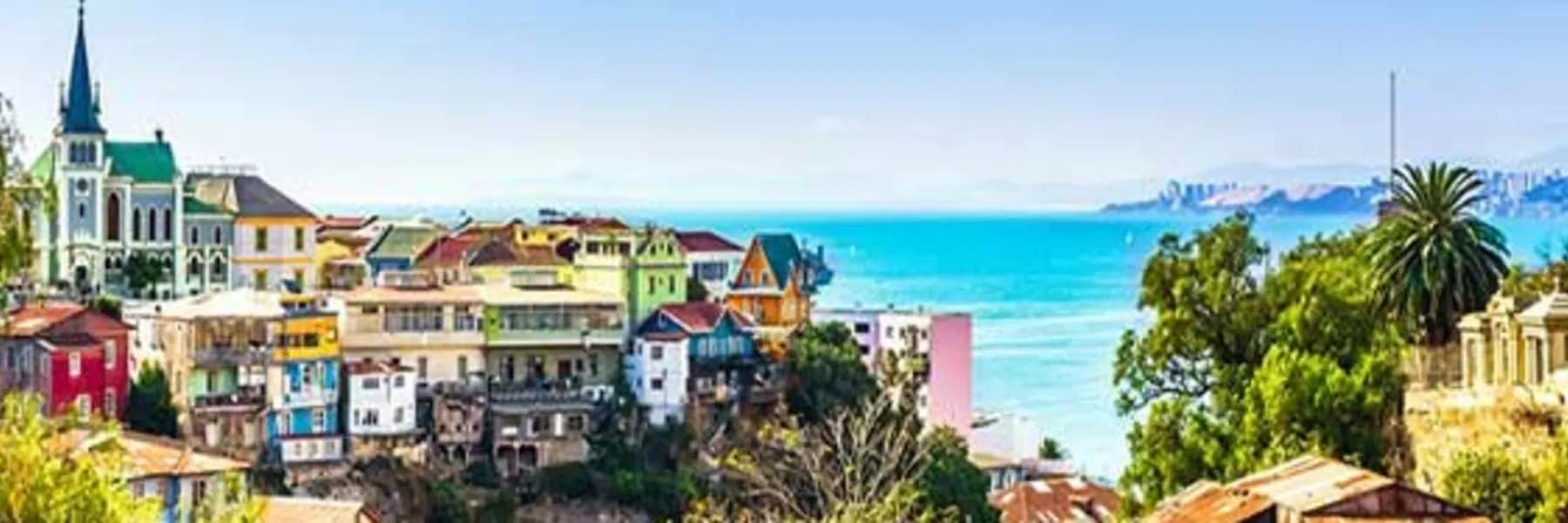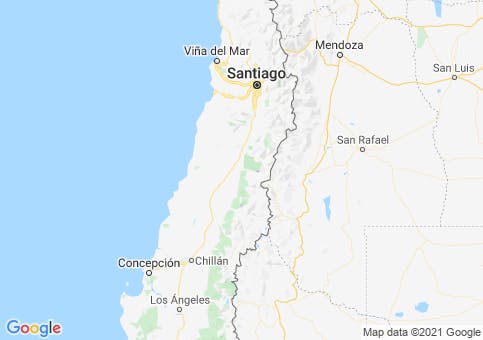By Michelle Thompson
The seaside city of Valparaíso, Chile has historically been the major port linking the country to the Atlantic and Pacific oceans. In 2003, it was designated as a World Heritage site by UNESCO. With its bohemian vibe and vast hills, the city has inspired poetry and writings by the likes of Pablo Neruda and others.
Valparaíso is known as the “Jewel of the Pacific” and is one of Chile’s most romantic cities. Before Spanish and European settlers arrived on the continent, Chile was inhabited by the Chango and Picunche Indigenous people. After the arrival of Spanish settlers, Valparaíso became known for its fishing industry and served as a stop-over port for travelers and Spanish explorers traveling along the coast. The El Mercurio building at the center of the city’s commercial area is where the first merchant pier was built.
Chile is located on the left of the Andes mountains and to the right of the Pacific Ocean. Valparaíso is only 794 feet from sea level. The upper town area is built on mountainous hills, and this is where most of the residents live. As such, walking around Valpo’s (as the locals call it) cobbled roads is an urban hiking experience.
Retire in Valparaíso, Chile
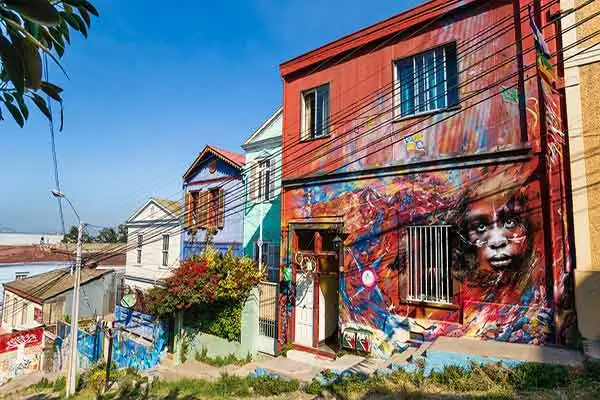
Valparaíso is located in central Chile and is less than two hours west of its capital, Santiago. As one of the top three destinations for expats, this city has a healthy international community and is a great example of Chilean culture. It offers visitors and residents amazing street art, musical events, savory foods, and a unique urban landscape.
Valparaíso is teeming with culture. The El Mercurio de Valparaíso is the world’s oldest Spanish-language newspaper. In the 1990s, locals started a grassroots movement to ensure the preservation of Valparaíso’s culture, graffiti art, and stairways. Today, the city also has annual jazz, opera, and multicultural music festivals. Its system of funicular lifts is also part of the preservation project. As well, the Valparaíso fireworks display can be enjoyed along the coast and is visible as far as neighboring Viña del Mar and Concón.
Boasting a population of nearly 300,000, Valparaíso’s yearly temperatures vary between 45 F to 83 F. The city sees about 372.5 mm of rain a year and the summer months are quite comfortable and sunny. The winter months can be cloudy and cool. The warm season lasts from December to mid-March, with January as its hottest month. During the cool season, from June to September, daily temperatures average around 61 F.
Valparaíso’s major industries include shipping and freight transport, tourism, and culture. The funiculars of Valparaíso, or “elevators”, help connect the lower and higher areas of the city. They are essentially a system of 12 cable cars transporting residents and visitors up and down the slope of the city.
The city’s port transfers 10 million tons of containers annually. Valparaíso has a reliable metro system that connects to Viña del Mar and other surrounding cities. You can also take a bus or trolley to get around many of the hills. A national bus system will also take you to Santiago or further into Chile.
The city of Valpo has many sports facilities, including the Velodromo Roberto Para, a cycle track with table football, as well as basketball and handball courts; the Estadio Elias Figueroa Brander, the historic site of football team Santiago Wanderers; and the Complejo Deportivo Escuela Naval which features a swimming pool and indoor and outdoor sports facilities.
Valparaíso residents rely on the Hospital Eduardo Pereira and two local medical clinics: Universidad de Chile’s Clinica Baron near St. Roque Hill and the Naval Hospital on Playa Ancha Hill. Chile has one of the strongest health systems in the world with many English-speaking doctors.
Still, Chile is a Spanish nation, and living here will be much easier if you learn how to speak and understand the official language. I struggled to find non-expats who could speak English and quickly realized I would need to learn. In fact, learning to speak Spanish has allowed me to meet locals and build friendships with them. Signing up for a Spanish class at Ecela Viña del Mar or at Instituto de Idiomas Natalis Language Centre will help you better navigate the area’s services.
Lifestyle in Valparaíso, Chile
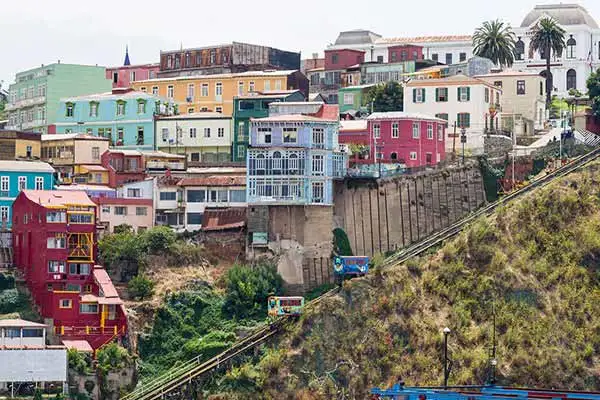
Expats in Valparaíso can have access to its annual New Year’s fireworks celebration which attracts many visitors from Santiago and surrounding areas. You will need to get a ticket quickly and you may encounter some traffic before and after the festivities. You can also enjoy many street food options as well as several high-end seafood or steak restaurants. Foodies and meat lovers rejoice. Chilean beef is high quality and the city’s proximity to the ocean means you’ll find fresh seafood products year-round. Chile is also known for its wines, and you can find a high-quality bottle for a cheap price.
The city’s architectural landscape features cathedrals and basilicas such as Catedra de Santiago and Catedral San Jose. Valpo has many police officers patrolling the streets, making it quite safe. It is known for its fitness programs and outdoor cinema during the summer months. You may also see some Chilean street theater now and then.
Chile is one of Latin America’s least corrupt countries. Poverty is relatively low, and many U.S. and Canadian expats choose to live here due to its low crime rate. The city is considered safe with the exception of a few mountain trails you should steer clear of at night.
Chile does have a winter and having a warm jacket and a small heater for the evening during those months is a good idea. One thing to keep in mind is that there are many street dogs. They tend to poop everywhere on the sidewalks and streets, so watch where you’re stepping! In addition, because the city is mostly made up of hills, you’ll need to prepare yourself for the extra effort it takes to walk places.
Cost of Living in Valparaíso, Chile
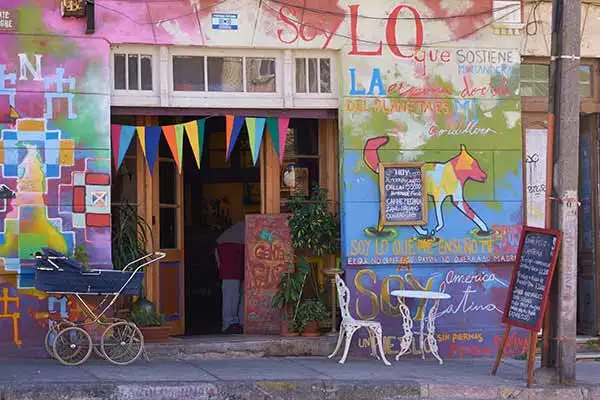
The cost of living in Chile is reasonable but not cheap compared to other Latin American countries. That said, Valparaíso itself is cheaper on average than most cities.
Expect to pay around $45 to $50 per week for groceries. Chile is known for its delicious high-quality wines. You can find a good bottle for a mind-blowing $5. As a Canadian who paid $15 to $25 for a good bottle of wine, I was so thrilled about this! As well, the price of an inexpensive meal is around $4 to $6 for one person. For something more high-end, you’ll pay around $20 to $24. Dining and entertainment for the month may run you as much as $250, depending on how often you go out.
Chile has a national health system with both public and private options. Public health care is focused on primary case, disease prevention and treatment, and promotion of health and wellness. The private sector focuses on specialized services. As an expat, you will be eligible for public healthcare once you have legal residency and pay taxes. The average private health insurance plan will cost around $70 to $140.
Valpo has a light rail system, and you can easily access an Uber or a collectivo (shared taxi) for about $2 a ride. Basic monthly utilities such as electricity, water, and garbage collection average around $80, and a WiFi/mobile phone package is around $30 to $45.
As a single expat, I calculated I could retire in Valparaíso comfortably for less than $1,000 a month. However, I live in a one-bedroom apartment and the estimates below are based on a three-bedroom unit which runs between $650 and $710 for a place in the city center. The average rent for a one-bedroom will run you around $400 a month. Rent prices decrease when you look outside the city center.
Below is a Monthly Budget Breakdown for Valparaíso, Chile:
| Expense | U.S. $ |
|---|---|
| Rent (three-bedroom apartment in the city center) | $650 to $710 |
| Utilities (gas, electric, water) | $80 |
| Internet/Telephone | $45 |
| Health Insurance | $70 to $140 |
| Clothing and Miscellaneous | $200 |
| Groceries | $300 |
| Transportation (mass transit/collectivo taxis/tank of gas) | $75 |
| Dining and Entertainment ($48/meal for two) | $250 |
| Monthly Total: | $1,670 to $1,800 |
Things to Do in Valparaíso
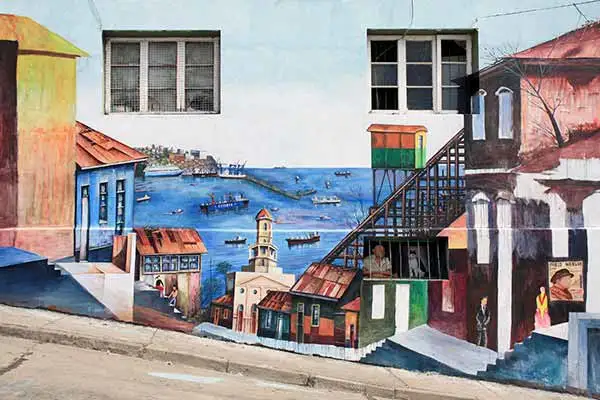
Valparaíso offers amazing places to see and things to do. The city is located near the ocean and the mountains, offering residents access to beaches and beautiful viewpoints called miradors—equally as beautiful as the colorful homes lining the hills of the city. Aside from the picturesque landscape, the city offers fun activities for expats to do.
If you’re someone who loves the seaside and are dreaming about owning an oceanfront property, Valparaíso could be your next home. While the city welcomes many tourists, the serene environment and amazing views can help create a sense of inner wellness and peace. Most water cities have excellent amenities, and you will have access to those whenever you like. However, consider the risk of saltwater damage or weather threats to your home.
You can quickly settle into a lifestyle of dining out and walking around discovering charming shops and coffee shops. Here are some of the most interesting things to see and do in and around Valparaíso:
Take a Street Art Tour
Valparaíso is a historic center filled with interesting street murals and art installations that tell its history. Taking one of the local Valpo Steet Art Tours is a worthwhile interactive experience. While following the local artistic graffiti and taking advantage of some great photo opportunities, you could have the chance to spray your own paint and learn tips on how to create graffiti for free. As well, consider researching Airbnb’s experiences section for several options.
Walk the Stairways or Ride the Funiculars
Valparaíso has some of the most spectacular views of its colorful houses on the city’s hills. Its city stairways will take you to some of the most spectacular views you’ll ever see. If walking up the stairways isn’t your thing, take one of the city’s many funiculars. Try walking up Montealegre Street to connect with Cerro Concepcion where you’ll marvel at La Santa Cruz Lutheran Church. As another option, take the El Peral funicular where you’ll have a great view of the Baburizza Palace, which houses the city’s Museum of Fine Arts. The bright buildings tightly aligned along the hills are best viewed while riding on one of the city’s funiculars. They amplify the city’s charm.
Take an ascensor (elevator in Spanish) or walk up the street’s stair system to enjoy a panoramic view of the city’s port. On your way up, you’ll get a real sense of the city’s sprawling landscape and once you position yourself higher up, you’ll witness some of the city’s best architecture.
Hike in Parque Nacional la Campana
Valparaíso’s most popular hiking trail is considered somewhat difficult but will offer some of the most beautiful views available in the region. Cerro la Campana is accessible by hiking through the Parque Nacional la Campana. When you step out of Valparaíso into the countryside, you’ll see some of the most beautiful hillsides.
The national park is located between Santiago and Valparaíso and has a 6,168-foot-high summit where you can see the ocean on one side and the Andes on the other. Be prepared, this is a full day’s hike. The entrance is accessible from the metro station in Viña del Mar (Viña del Mar Estacion Central) for $2.50. A ticket to enter costs around $10. Keep in mind that the entire trek is around 14 miles which can be a challenge if you’re not fit.
Nearby Olmué-La Campana is one of the most difficult trails in the area. Its distance is just under five miles and the elevation is 5,220 feet. The trail is a one-way trek so hikers will need to arrange for transportation after they arrive at the end. There is a bus stop near the national park entrance.
Expert Tip: Bring comfortable shoes, a jacket, and some water if you’re planning on walking the entire Cerro la Campana trail. It can get cold the higher you get and the trek is an entire day’s walk.
Visit the Bellavista Hill and Open-Air Museum
Take a walk on the streets of Cerro Bellavisto and visit the open-air art gallery (Museo a Clielo Abierto). The collection of wall murals makes a rich contribution to the city’s vibrant yellows, reds, and blues. The museum features Chilean artists like Jose Balmes, Roberto Matta, and Mario Toral. The painters were commissioned to create the street art which was then painted by students from the local university.
Visit the Viña Del Mar Beaches
If you prefer the idea of lounging on the beach, a trip to Viña Del Mar will offer you what you need. Playa Renaca is less than thirty minutes outside of Valparaíso. This lovely beach has sand dunes you can climb, and shops and restaurants are accessible at the center of the village of Renaca. There are scenic ocean views as well. This beach can be crowded during the summer months because it’s popular with local Chileans. Playa El Sol in Viña Del Mar offers a long stretch of beach with a nearby bike path. You can reach it by transit or metro. Nearby, you’ll have access to fast food restaurants like Churricos.
Enjoy Amazing Seafood
Some of Valparaíso’s best restaurants are known for their sustainable seafood. Many business owners are dedicated to making sure they only serve fresh fish caught by local fisherman. Apice Cocina del Mar is a favorite of mine. Its romantic atmosphere and breathtaking view of the port and ocean are the main highlight and feel ultra-romantic. Their impressive wine list features regional options and their ceviche is a must-try.
Other local favorites include Cocina Puerto which has friendly wait staff and typical Chilean dishes like sweet, crunchy pork. Peruvian food is also popular in Chile. Try Nazca Restaurante for a delicious pisco sour and a shrimp or fish encocado dish.
Featured Image Copyright: ©StreetFlash/iStock
